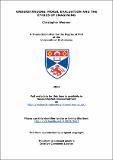Files in this item
Understanding : moral evaluation and the ethics of imagining
Item metadata
| dc.contributor.advisor | Gaut, Berys Nigel | |
| dc.contributor.author | Woerner, Christopher | |
| dc.coverage.spatial | 139 | en_US |
| dc.date.accessioned | 2013-06-11T15:39:30Z | |
| dc.date.available | 2013-06-11T15:39:30Z | |
| dc.date.issued | 2013-06-27 | |
| dc.identifier.uri | https://hdl.handle.net/10023/3667 | |
| dc.description.abstract | Analytic ethics often neglects the exploration and appreciation of morality as it is actually practised on a day-to-day basis. But by looking at how, in a practical sense, we are able to interact with others in a morally appropriate way we can construct a compelling picture of what some of our most pervasive obligations are. This thesis takes such an approach through the concept of understanding – understanding essentially taken here to involve those processes involved in detecting and correctly responding to beings typically possessing inherent moral significance. In the first two chapters ‘understanding’ and the understanding approach are themselves explicated, and placed in the context of several other related approaches in the English-speaking tradition – Adam Smith’s Theory of Moral Sentiments, Nel Noddings’ ethics of care and Richard Hare’s preference utilitarianism. This approach is then used to provide us with an alternative idea about what our moral reasoning suggests to be of fundamental ethical significance, and of what kinds of activity morality recommends to us. The activity explored in most detail here is that of engaging with fiction – or more broadly, fictive imaginings. While understanding shows us that fictional characters and events themselves cannot have an inherent moral valence or significance, it also shows us when and how it is possible and appropriate to ethically assess fictive engagement, be it as creator or consumer. This is seen after exploring how and in what ways our moral understanding can be appropriately applied to and exercised by fictions at all, and why fiction should be of particular interest to the understanding agent, looking at the work of Martha Nussbaum, Jenefer Robinson, Peter Lamarque and others on aesthetic cognitivism. Ultimately this leads us to discern a minimal ethical constraint on our interpretation of fiction and art in general, further proving understanding’s usefulness. | en_US |
| dc.language.iso | en | en_US |
| dc.publisher | University of St Andrews | |
| dc.rights | Creative Commons Attribution-NonCommercial-NoDerivs 3.0 Unported | |
| dc.rights.uri | http://creativecommons.org/licenses/by-nc-nd/3.0/ | |
| dc.subject | Ethics | en_US |
| dc.subject | Aesthetics | en_US |
| dc.subject | Art | en_US |
| dc.subject | Understanding | en_US |
| dc.subject | Interpretation | en_US |
| dc.subject | Imagination | en_US |
| dc.subject | Fiction | en_US |
| dc.subject | Simulation | en_US |
| dc.subject | Sympathy | en_US |
| dc.subject | Cognitivism | en_US |
| dc.subject | Richard Hare | en_US |
| dc.subject | Peter Singer | en_US |
| dc.subject | Adam Smith | en_US |
| dc.subject | Nel Noddings | en_US |
| dc.subject.lcc | HM1166.W7 | |
| dc.subject.lcsh | Interpersonal communication--Moral and ethical aspects | en_US |
| dc.subject.lcsh | Comprehension | en_US |
| dc.subject.lcsh | Applied ethics | en_US |
| dc.subject.lcsh | Literature and morals | en_US |
| dc.title | Understanding : moral evaluation and the ethics of imagining | en_US |
| dc.type | Thesis | en_US |
| dc.type.qualificationlevel | Doctoral | en_US |
| dc.type.qualificationname | PhD Doctor of Philosophy | en_US |
| dc.publisher.institution | The University of St Andrews | en_US |
This item appears in the following Collection(s)
Except where otherwise noted within the work, this item's licence for re-use is described as Creative Commons Attribution-NonCommercial-NoDerivs 3.0 Unported
Items in the St Andrews Research Repository are protected by copyright, with all rights reserved, unless otherwise indicated.


